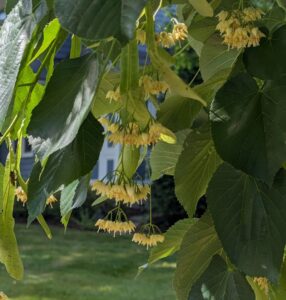 Ever since my daughter was a little girl we have made small, sentimental journeys at various times of the year. In spring, we check our favorite garden centers religiously for the first plant arrivals and visit as soon as the pansies hit the pallets. We brave the crowds and the parking challenges to get to the Philadelphia Flower Show every March. At Christmas, we return to the garden center, where the same pallets that showcased our spring pansies are full of trees, wreathes and decorative roping.
Ever since my daughter was a little girl we have made small, sentimental journeys at various times of the year. In spring, we check our favorite garden centers religiously for the first plant arrivals and visit as soon as the pansies hit the pallets. We brave the crowds and the parking challenges to get to the Philadelphia Flower Show every March. At Christmas, we return to the garden center, where the same pallets that showcased our spring pansies are full of trees, wreathes and decorative roping.
But one late spring pilgrimage that costs nothing and yields joy is our trip to bask in the delicious fragrance of the linden trees in my town and nearby towns. This usually happens in mid to late June, depending on weather, when the relatively inconspicuous buds on the local lindens open, revealing gloriously fragrant clusters of yellow flowers. Usually you can smell them from at least half a block away. You can also hear a symphony of buzzing from the crowds of bees feasting on linden nectar.
It seems to me that nearly every city and town in the eastern half of America boast a “Linden Street” or a “Linden Avenue”. Most of those roadways were originally planted with American linden trees, known botanically as Tilia americana. Then as now, the lindens were deciduous beauties. They made perfect street specimens back in the day when the strip between street and sidewalk was big enough to accommodate the roots of a shade tree that can grow sixty to eighty feet tall, with a spread equal to at least half the height. As the decades advanced, cars grew larger and traffic denser, making those curbside strips narrower. Now linden root zone requirements are often too big to make them desirable street trees, but older trees remain. Younger specimens are perfect for large lawn areas or parks.
Mature lindens are at their showiest in June, but they are lovely at all time, with large, rounded crowns. The slightly toothed, heart-shaped green leaves provide ample shade, sometimes turning pale yellow before leaving the scene in the fall. For even greater interest, combined with the same glorious flowers, look for silver linden or Tilia tomentosa. The leaves are dark green on top and silvery white on the bottom, which makes the trees dramatically beautiful, especially when breezes ripple the silvery leaves.
Like many well-loved trees, lindens have acquired a host of nicknames. Americans sometimes refer to the trees as “basswood”. One variety, Tilia heterophylla or white basswood, is also known as “beetree linden”, a nod to the ongoing love affair between bees and linden blooms. In Europe, linden species, including littleleaf linden—Tilia cordata—and European linden—Tilia x euopaea, are known as lime trees. This is not because they are related to the citrus fruits of the same name. “Lime” is probably a corruption of the word “lind”, which shares roots with other words that mean “flexible”. That flexibility has factored in the traditional uses of clipped lime trees for hedging, as well as the creation of living tunnels by the careful training of the branches of parallel rows of trees. The technique of interweaving young branches to create these green structures is called “pleaching” and involves training the fast-growing shoots, monitoring their growth and trimming off stragglers. A very famous pleached lime walk, created by Vita Sackville-West, has long enchanted visitors at Sissinghurst in Kent, England.
Linden trees have been celebrated by poets and composers. The genus also figures in art and craft history, as it is well suited to carving and turning. The great seventeenth century English artisan, Grinling Gibbons, created intricately carved screens, mantles and other wooden structures bedecked with garlands of exquisitely rendered flowers, branches, fruit, foliage and wildlife. Linden was his wood of choice, as it is for American contemporary carver and Gibbons expert, David Esterly. Esterly’s book, Grinling Gibbons and the Art of Carving, is a thorough discussion of this fabulous art–perhaps the ultimate expression of the innate beauty of linden wood–by a fellow artisan who has restored some of Gibbons’ work.
For linden fragrance lovers, the great size of the trees is an asset, providing an enormous number of flowers, but for modern gardeners, size can be a liability. If you want to grow a linden tree in your back or front yard, but don’t have the requisite acreage for a full-size specimen, seek out the little-known, but lovely Japanese linden or Tilia kiusiana. It maxes out at only thirty-two feet tall and wide, boasts smaller leaves and interesting exfoliating bark, and can be grown as a large shrub or small tree. The Japanese species features the same fragrant flowers as other lindens, with leaves that turn an attractive yellow in the fall. With intelligent pruning, it might even be kept smaller than its maximum height and spread.
Whether you select the native American linden, or one of its European or Asian relatives, make sure to provide the tree with sunshine, plus rich, loamy soil and uniform moisture levels. The American species is sometimes used in flood plains, the sides of streams and other places that retain moisture. Mulch young trees well and water even mature specimens during dry spells.
Good nurseries and garden centers sometimes carry one or two Tilia species or varieties. For a good selection, try ForestFarm, PO Box 1, 14643 Watergap Road, Williams, OR 97544, (541) 846-6963; www.forestfarm.com. Print catalog available.
